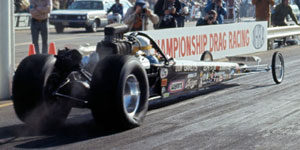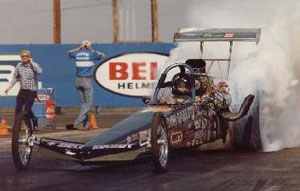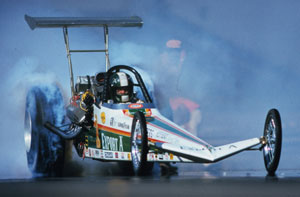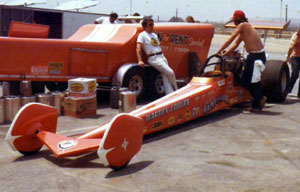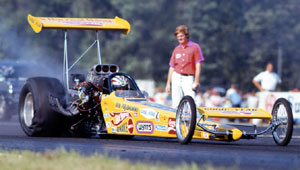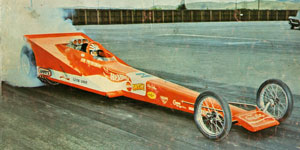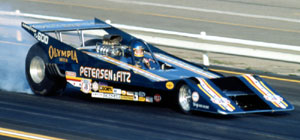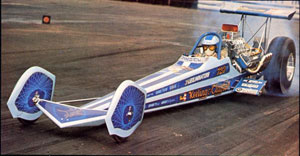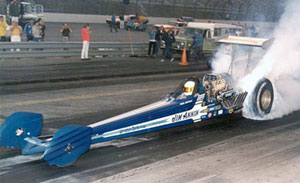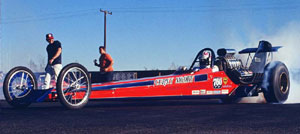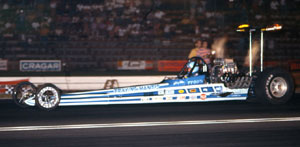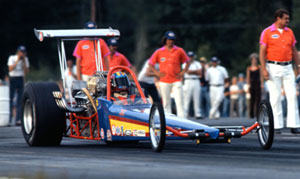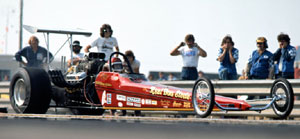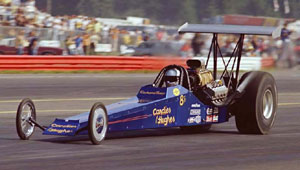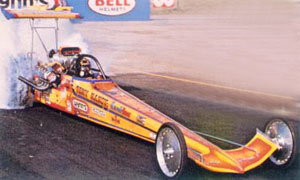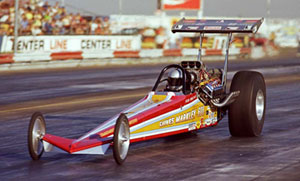

Favorite Race Car Ever voting: 1970s Top Fuelers
|
|
||
|
|
||
|
|
||
|
|
||
|
|
||
|
|
||
|
|
||
|
|
||
| Final results for all-time favorite '70s Top Fueler! | ||
| Don Garlits Swamp Rat 22 |
582
|
(15.31%) |
| Warren-Coburn-Miller Rain for Rent |
561
|
(14.78%) |
| Don Garlits Swamp Rat 14 |
519
|
(13.65%) |
| Don Prudhomme Yellow Feather |
349
|
(9.17%) |
| Keeling & Clayton California Charger |
344
|
(9.06%) |
| Don Prudhomme Hot Wheels wedge |
281
|
(7.40%) |
| Candies & Hughes |
229
|
(6.03%) |
| Beck & Peets Export A |
162
|
(4.26%) |
| Jim Bucher Chevy |
149
|
(3.92%) |
| Tony Nancy Revell-liner |
149
|
(3.92%) |
| Petersen & Fitz Can-Am |
123
|
(3.24%) |
| Jeb Allen Preying Mantis |
102
|
(2.68%) |
| "Diamond Jim" Annin/Mike Snively |
75
|
(1.98%) |
| Walton-Cerny-Moody |
73
|
(1.93%) |
| Gaines Markley/Rob Bruins |
53
|
(1.39%) |
| Larry Dixon Sr./"Real Don Steele" |
48
|
(1.26%) |
|
Total Votes: 3800 (projected)
|
||
|
|
||
|
|
||
|
|
||
|
|
||
|
|
||
|
|
||
|
|
||
|
|
||
Welcome to the 1970s, my poll-loving friends. Well, so far we’ve worked our way through the 1950s and 1960s, picking your favorite early door cars, Top Fuelers, and Funny Cars (the latter of which you still can vote on; scroll down to the previous column entry). Now it’s time to get down with some groovy cars from the 1970s, beginning with 16 of your favorite nominated Top Fuelers in the next round of our Favorite Race Car Ever poll.
As always, the 16 entries in the poll were submitted by the readers of this column, and, again, they did not disappoint. Personally, I can’t think of many of the most popular cars from that magical era that aren’t included (although I’m sure some of you will). So, here we go.
The ’70s, of course, brought us into the rear-engine era of Top Fuel. Sure, there had been a lot of back-motor cars of all varieties in the preceding decades, but it took “Big Daddy” Don Garlits to prove that the concept would work. The story is familiar to even casual fans, how “Large Father” lost half of his right foot in a clutch explosion in his aptly numbered Swamp Rat 13 front-engine dragster at Lions Drag Strip in 1970 and spent part of his hospitalization drawing up plans for SR14, his first rear-engine car (the other part watching Star Trek, if you believe Tom McEwen). It took a little bit of testing before hitting on the right steering ratio, but once that was sussed out, “Big” was runner-up at Lions’ AHRA Grand American and two weeks later won the 1971 NHRA Winternationals and then the March Meet, and the Top Fuel world as we know it changed forever. The car ruled the quarter-mile, chalking up the year’s six quickest e.t.s, including a monster 6.21 during qualifying at the U.S. Nationals (the race that ended with his famous burndown loss to Steve Carbone’s slingshot); the next quickest driver was Ted Thomas, who ran 6.33 in the Jade Grenade.
Longtime drag fan Cliff Morgan was among those nominating this historic car, because he was there when SR13 came apart. “I saw the accident at Lions, and it scared me — I thought Garlits had died,” he said. “The ‘Old Man’ has always been my hero. I always rooted for him and wanted him to win everything. I remember reading an article in Drag News in late 1970 that Garlits had built a rear-engined car. I thought he was nuts. Rear-engined cars always crashed (with a few exceptions, like the Kaiser Bros. out of
This wouldn’t be any kind of 1970s Top Fuel poll if it didn’t include at least one other Garlits car, and for many that car has to be Swamp Rat 22, the amazing machine with which Garlits not only won the 1975 NHRA world championship but also recorded one of the all-time great performances in drag race history, his stunning 5.637 at the 1975 NHRA Supernationals/World Finals at Ontario Motor Speedway. As reported in previous entries in this column, that e.t. was not bettered until 1981, and the national record stood until 1982. The car also carried him to victories at the Winternationals, Le Grandnational, and the U.S. Nationals, his fourth of eight Indy wins.
Recalls reader Danny Durham, “I'm fortunate enough to say I was at [the 1975
Between Garlits’ early 1970s dominance and his mid-1970s resurgence, a new force emerged from the Northwest in the form of Gary Beck, a Seattle-area native (again, he was not and never was Canadian). With a two-week-old Top Fuel license in his pocket, Beck, who had cut his teeth with partner Gaines Markley in 200-mph Top Gas machines, surprised the field at the 1972 U.S. Nationals, then came back and did it again in1973 with a new partner, Canadian Ray Peets. In 1974, they flew the sponsorship banner for the MacDonald’s Tobacco Co. and its Export A brand, and the green, white, and red Export A machine quickly became the most feared car in the land. They won the Winternationals, the Springnationals, and Le Grandnational and the world championship — the first based solely on points — and challenged Garlits for the 1975 title. The Woody Gilmore-built car actually beat Garlits to the 5.60 zone at that famous 1975
Garlits and Beck may not have had many national equals in the mid-1970s, but on the West Coast, even they had their hands full with the potent Ridge Route Terrors, the fabled Warren & Coburn (and later Miller) team whose orange dragsters were the scourge of the region dating back into the late 1960s. They won the prestigious March Meet with dominating regularity, and though their NHRA national event record shows just two wins and two runner-ups (Warren was the runner-up to Garlits in Indy 1967, leading to Garlits’ famous shave), they were feared on tracks near and far.
Recalls reader Steve Spurling, who grew up in Southern California in the 1960s within an hour’s drive of San Fernando, Irwindale, Lions, OCIR, and San Gabriel, “The legend was that spotters would sit up in the Ridge Route (Interstate 5) and see which way this team was headed after coming down the mountain; staying on the I-5 meant Irwindale, or turning onto the 405 [freeway] meant Lions or Orange County. They were so good that other drag racers would go to whatever track they were not going to so they might have a chance at winning.”
Apparently the team wasn’t always all business. Mark Mallory, whose dad worked for the RRT in the 1970s, recalls one time at OCIR when he was about 8 and “Uncle James” told him and his brother to sneak over to Garlits’ pit and hide his fuel jugs. “We got caught,” he remembered, “and Don and the crew put Swamp Rat T-shirts on us, duct-taped our arms together, and tied our shoelaces around our legs. He sent us back to James’ pit with notes taped to our foreheads; I think they had some bad words on them because we weren’t allowed to read them.”
Although he was best-known in the 1970s as the decade’s dominant Funny Car pilot, Don Prudhomme had a couple of memorable Top Fuel cars as well, two of which made the poll.
The first car was actually one of “the Snake’s” last Top Fuelers (until his return to the class in 1990) but the car earned a spot in the history books for winning what was then the quickest side-by-side Top Fuel race in history to kick off the 1972 season. His yellow Hot Wheels dragster was Swiss-cheesed from one end to the other and known as the Yellow Feather for its light weight. Prudhomme and John Wiebe dueled in the final round at Lions Drag Strip’s Grand Premiere Jan. 16, 1972, which Prudhomme won on a close 6.174 to 6.175 count over “Kansas John’s” Donovan-powered slingshot. The race was remarkable not just for its closeness but because the e.t.s were the quickest ever, supplanting the home-run 6.21 shot Garlits had fired in Indy the year before. Prudhomme didn’t run much in Top Fuel after his Funny Cars became his calling card, but the Feather left a heavy impression.
Speaking of heavy impressions, Prudhomme certainly left one with his second car on our balloting, his short-lived Hot Wheels wedge dragster, which was built by John Buttera, who also built Prudhomme’s early Funny Cars. The idea was to remove the drag of a rear wing and use aerodynamics to their advantage. A number of Top Fuel drivers, including Connie Kalitta and Leland Kolb, tried the wedge design but found it either ill-handling (Kalitta stacked his up spectacularly in Indy) or too heavy. Of interest probably only to me, the image in the poll at right was taken from the cover of my souvenir program from the 1971 PDA event, July 23-24 … my first drag race. Yep, still have the program. Prudhomme somehow made it to the final but lost to Rick Ramsey in the then quickest side-by-side race in history, 6.41 to 6.41. I remember staring at the OCIR scoreboards behind the starting line, where the identical 6.41s were posted and wondering how my hero had lost. It was my introduction to the concept of a holeshot win.
The wedge dragsters weren’t the only anomalies in the early 1970s as “the Northwest Terror,” Herm Petersen, and partner Sam Fitz tried a Can-Am approach to fuel dragster racing in 1974 with backing from
While the women of the 1970s were wearing hot pants, a different fashion accessory was sprucing up the looks and the aerodynamics of 1970s Top Fuelers — front-wheel pants — and no dragster looked sexier wearing them than the already spectacular John Keeling- and Jerry Clayton-owned California Charger rear-engine dragster. Both the front-engine and rear-engine California Chargers were nominated, but I’ve decided to combine them into a single entry. With their trademark Cerny-applied dark-blue/light-blue-striped paint jobs and plenty of chrome, the cars were sharp-looking and, under the controls of drivers such as Ramsey, Norm Wilcox, and John Stewart, actually ran as well as they looked, which is an oft-overused cliché but well-deserving here. The front-engine car won the 1970 Supernationals title (and Best Appearing Car) with Ramsey and was runner-up to Garlits’ new rear-engine car at the 1971 March Meet, then won the aforementioned PDA race against Prudhomme’s wedge. With Stewart, currently the crew chief for Morgan Lucas’ two-car Top Fuel team, at the wheel of the back-motor car, they became the ninth member of the Cragar Five-Second Club with a 5.92 at the 1973 Supernationals.
“Keeling and Clayton's California Charger full-bodied slingshot — 200-mph artwork. Come on, what's prettier than THAT?” begged Michael Ogle.
Another historic car that wore wheel pants well was “Diamond Jim” Annin’s Mike Snively-driven dragster that broke the five-second barrier at the 1972 Supernationals. With the pretty car, Snively became not just the first five-second racer but also the first five-second loser as he was defeated on a holeshot by Vic Brown, 6.03 to 5.97. After he retired from racing, “Diamond Jim” joined the NHRA Safety Safari and was a well-loved member of the NHRA family. The memorial after his passing in late 2004 drew a standing-room-only crowd estimated at 500 to the
The next car didn’t have wheel pants, but it’s seldom that anyone talks about the Annin/Snively car without mentioning the Walton-Cerny-Moody car in the same sentence. After all, earlier that day, driver Don Moody had run 6.00 in round two at 232 mph, then shut off early to a 6.01 at just 202 mph (!) in the semifinals, either run of which could have given him the historic mantle. Moody, who earlier in the year had won the National Challenge in
The team initially was made up of just Moody and crew chief Wes Cerny, who worked together at Engle Cams in Santa Monica, Calif., where Moody was the general manager and Cerny the machine shop foreman; Doug Walton, who previously ran a front-engine Top Fueler of his own, knew Cerny from the their earlier racing days in the Midwest and joined them for the 1972 through 1974 seasons. The first rear-engine Cerny & Moody car they fielded in late 1971 was the memorable Don Long-built car pictured to the right, a 392-powered machine that featured a vertical fin between the rear tires to help stabilize the car; Long preferred to refer to it as a “feather” because its function was to help keep the car on a straight course, like a feathered tail on an arrow. “How well it worked I'm not sure; the car went straight and was effortless to drive, being our first rear-engined car, we were not sure what to expect,” Moody told me via e-mail from his home in Chiang Mai, Thailand, where he has lived since 1994, but the car immediately set track records at Orange County, Lions, Irwindale, and Carlsbad. “The car worked well enough that we knew we needed more power, so rather than try and worm a 426 Hemi into this one, we opted for a whole new Don Long chassis and a Keith Black 426 Hemi with a two-speed transmission. We sold the complete 392 engine and chassis to Lyle Dill in
Teenage race fans in the early 1970s dreamed about being Jeb Allen, who at the tender age of 17 earned his Top Fuel license, following older brothers Ed and Les into the cockpit of the family cars owned by their parents, Guy and Betty. The team’s previous cars, including a Jr. Fueler, had insect-related names such as The Wasp and Stinger, but when they went to Top Fuel in 1969, with Les at the wheel, the first Preying Mantis began preying on the competition. Allen, who had spent the previous year on tour with Steve Carbone, took over the wheel in 1971 — “it was his turn,” said Betty — and made his debut in November at Lions and promptly ran 6.60s. He won the prestigious NHRA Summernationals the next season, a month after his 18th birthday, and won the event back-to-back in 1978 and 1979 and two other NHRA titles. By the end of the decade, Allen had won the 1977 AHRA championship and followed with an IHRA crown in 1981 and the big one, the NHRA championship, in 1981. Allen also has the distinction of being the last driver to cross the finish line at fabled Lions Dragstrip when he crossed the stripe second to Carl Olson on that sad night, Dec. 2, 1972 (well, because the event ended well after 2 a.m., I guess I should say that sad morning of Dec. 3). As an aside, Allen’s son,
Another cool thing about 1970s Top Fuel racing was that it wasn’t all Chrysler all the time; several drivers were serious contenders with their Chevrolet mounts, chief among them Jim Bucher. A former national-event-winning Top Gas racer (1971 Supernationals), Bucher, an electrician by trade, ran nothing but Chevys in his Top Fuel career, which began in 1972 after the Top Gas cars were phased out of their own eliminator. Bucher set the national record at 6.07 at the 1973 Gatornationals and qualified No. 1 in Indy later that year. Two years later, he became the first Top Fuel driver in the modern era to win an NHRA national event with Chevy power when he beat Beck in the final of the 1975 Summernationals and even led the points for a short time. Fighting a rare blood disease sapped his funds and his strength, and he finished fourth in points and died two years later.
Larry Dixon Sr., father of the two-time NHRA POWERade Top Fuel world champ, had a pretty-darned-good-running Chevy Top Fueler, too, in the early 1970s and had the only Chevy-powered car in the famed 16-car Cragar Five-Second Club after ripping off a 5.94 at Ontario in 1973. The Howard Cams Rat, which also enjoyed backing from Los Angeles radio personality “The Real Don Steele,” was the explosive runner-up to Garlits in the first Five-Second Club race (which pitted the first eight cars to run under six seconds), which was held at Irwindale, where Dixon’s mount bombed the blower right at the green.
The Candies & Hughes team may have begun and ended its time in the spotlight in the Funny Car class, but in the middle 1970s through the early 1980s, it fielded some mean Top Fuel cars, too, driven by the likes of Dave Settles, Bill Wiggington, Richard Tharp, and Mark Oswald. Settles wheeled the car to an impressive victory at the 1974 Gatornationals, qualifying No. 2 and running low e.t. of every round but the first and winning on Beck’s final-round red-light. Settles finished second in points that year, and Wiggington ran the car through 1975 before giving way to “King Richard,” who had caught their eye after qualifying the Texas Whips car of Curt and Bones Carroll No. 1 at 1975 NHRA Summernationals, crossing the finish line on fire with a 5.97. Tharp’s devil-may-care attitude and Candies & Hughes horsepower carried them to some lofty accomplishments.
Tony Nancy made a living making the insides of cars beautiful with his upholstery business, but “the Loner” also knew how to make ’em pretty on the outside, too, as evidenced by his mid-1970s Revell-liner dragster. Nancy, who came to fame in the 1960s with his 22Jr. roadster and innovative and winning gas dragsters, was a former dry-lakes racer who burst onto the national scene with a win in Comp at the 1963 Winternationals and was the captain of the U.S. team that toured Europe in 1964. He debuted in Top Fuel in 1970 and was runner-up to Dixon at that year's Winternationals with a front-engine car and two months later won the prestigious U.S. Fuel and Gas Championships in Bakersfield, where he also was runner-up in 1974 and 1976. Nancy retired from the cockpit after the 1976 season to concentrate on his upholstery business and was honored with a Lifetime Achievement Award at the 1997 California Hot Rod Reunion before passing away seven years later.
And, last but not least, the fan-favorite Top Fueler of Gaines Markley and Rob Bruins, Top Fuel champion in 1979 and still the only Pro team to score a championship without winning a single event. Markley drove his own line of Assassin cars for years before putting the young Bruins behind the wheel late in 1976 after hurting his hand in a work accident. Bruins was fresh off a short stint driving the Green Elephant Funny Car and took to the dragster right away. They won the Fallnationals in 1978 and the championship in 1979. Although they didn’t win a national event, they were runner-up three times and won six times on the divisional level, which in those days counted toward the total score. Gaines passed away earlier this year, but his cars and his legacy are still warmly remembered.
Okay, there you have it: the 16 favorite Top Fuel cars as nominated by the readers of this column. It’s another tough field — too tough to imagine picking only one, but that’s your job.

| Final results: all-time favorite Early Dragster | ||
| The Freight Train |
725
|
(19.02%) |
| Beebe & Mulligan’s Fighting Irish |
639
|
(16.76%) |
| Don Garlits’ Swamp Rat VI |
447
|
(11.73%) |
| Greer-Black-Prudhomme |
433
|
(11.36%) |
| Tommy Ivo’s Showboat |
294
|
(7.71%) |
| The Surfers |
251
|
(6.58%) |
| Don Garlits’ Swamp Rat I |
239
|
(6.27%) |
| Eddie Hill’s Double Dragon |
207
|
(5.43%) |
| Flamin’ Frank Pedregon’s Fiat |
133
|
(3.49%) |
| Baney-Pink-Prudhomme |
95
|
(2.49%) |
| The Frantic Four |
94
|
(2.47%) |
| Speed Sport Roadster |
91
|
(2.39%) |
| Arfons Bros. Green Monster |
61
|
(1.60%) |
| The Glass Slipper |
41
|
(1.08%) |
| Stellings and Hampshire |
39
|
(1.02%) |
| Winkle & Trapp MagiCar |
23
|
(0.60%) |
|
Total Votes: 3812
|
||
Voting closed during the weekend in both the Early Dragsters and Early Funny Cars polls after some frantic voting. The Funny Car voting actually topped out at the peak mark of 3,800 votes despite a six-day head start for the rail jobs, but, after noting the tallies at the time, I let both of them run throughout the weekend since y'all were having so much fun.
No real surprise for me in the Early Dragsters poll as the readers here testified to their love for the Freight Train after my May 23 column on the amazing dual-motor machine, but it was a great battle with the Beebe & Mulligan Fighting Irish dragster, which had jumped out to a big early lead only to have the Train go steaming past.
A monster battle also was waged for third place between two iconic dragsters of the early 1960s, Don Garlits’ 200-mph-barrier-breaking Swamp Rat VI and the almost-unbeatable Greer-Black-Prudhomme dragster. I'm not sure if these two ever raced head to head, but I’d like to have seen it.
The poll kind of tapered off from there down to “T.V. Tommy’s” four-engine Showboat and the Jobe-Skinner-Sorokin Surfers car in fifth and sixth, but if passion counted for more than one vote each, the Surfers would definitely have been higher.
Again, other than the Train, I’m not sure how many of these cars will make it through to the second round until the votes are tallied in all seven polls, but it’s a good bet that at least Beebe & Mulligan will live to fight another day.
As testament to their continuing popularity, the Early Funny Cars poll definitely runneth over with more than 4,200 votes being cast in a six-day period. It’s by far been the most popular poll so far in terms of participation, even without the reader nomination of two important cars of the era, the flip-top Mercury Comets of Jack Chrisman and Don Nicholson.
| Final results: Early Funny Cars | ||
| Jim Liberman’s '66 Chevy II |
755
|
(19.87%) |
| Blue Max ‘69 Mustang |
715
|
(18.82%) |
| Chi Town Hustler '69 Charger |
645
|
(16.97%) |
| Gas Ronda’s Ford Mustangs |
263
|
(6.92%) |
| Bruce Larson's USA-1 '69 Camaro |
202
|
(5.32%) |
| Sachs & Sons/Chrisman Mercury Comet |
199
|
(5.24%) |
| Ongais/Foster/Thompson'69 Mustangs |
179
|
(5.14%) |
| Roland Leong's Hawaiian '69 mini Charger |
159
|
(4.18%) |
| Arnie Beswick's Tameless Tiger '66 GTO |
153
|
(4.03%) |
| Mazmanian/Siroonian '69 Barracuda |
108
|
(2.84%) |
| Candies and Hughes '69 Barracuda |
115
|
(3.03%) |
| Doug Thorley’s '66 Corvair |
87
|
(2.29%) |
| Beach City Corvette |
72
|
(1.89%) |
| Nelson Carter’s Super Chief Chargers |
72
|
(1.89%) |
| Secret Weapon Jeep |
45
|
(1.18%) |
| Gay Bros. Infinity III ’67 ’rainbow’ Firebird |
32
|
(0.84%) |
|
Total Votes: 3800
|
||
I have to admit that I was quite surprised by the results, figuring that the Chi-Town Hustler would dominate on name recognition among those newer to the sport and the car’s well-publicized role in the growth in popularity of the showy burnout.
Then again, I should have known better than to hedge against anything “Jungle”; it’s clear that more than 30 years after his passing, Russell James Liberman is still a god to many drag racing fans, and his Chevy II clearly was part of the king-making process.
I was equally surprised then to see the Blue Max also smoke past the Hustler in the voting and fall just 40 points shy of unseating Liberman. There’s no doubt that the Blue Max name is well-known and respected throughout drag racing lore, but clearly Harry Schmidt’s Mustang left a pretty strong impression. As in all of the polls, the individual winner gets the ride to round two, and we’ll have to see if the Max and Hustler also make it there.
All of these Early Funny Cars battles set the stage for the 1970s Funny Car poll that will be coming — either later this week or a week from today, depending on what else crops up on the DI radar — because fans will have to choose again between “Jungle” and the Max, with a couple of “Snakes” and a “Mongoose,” among 11 others, thrown in for good competition. Based on the popularity of 1970s Funny Cars and the nostalgia that emanates from their very mention like a strong dose of nitro up the snout, this is the poll I’ve most looked forward to since the inception on the contest.
Again, thanks for playing, keep on voting, and let’s get this thing down to the finals!




















































